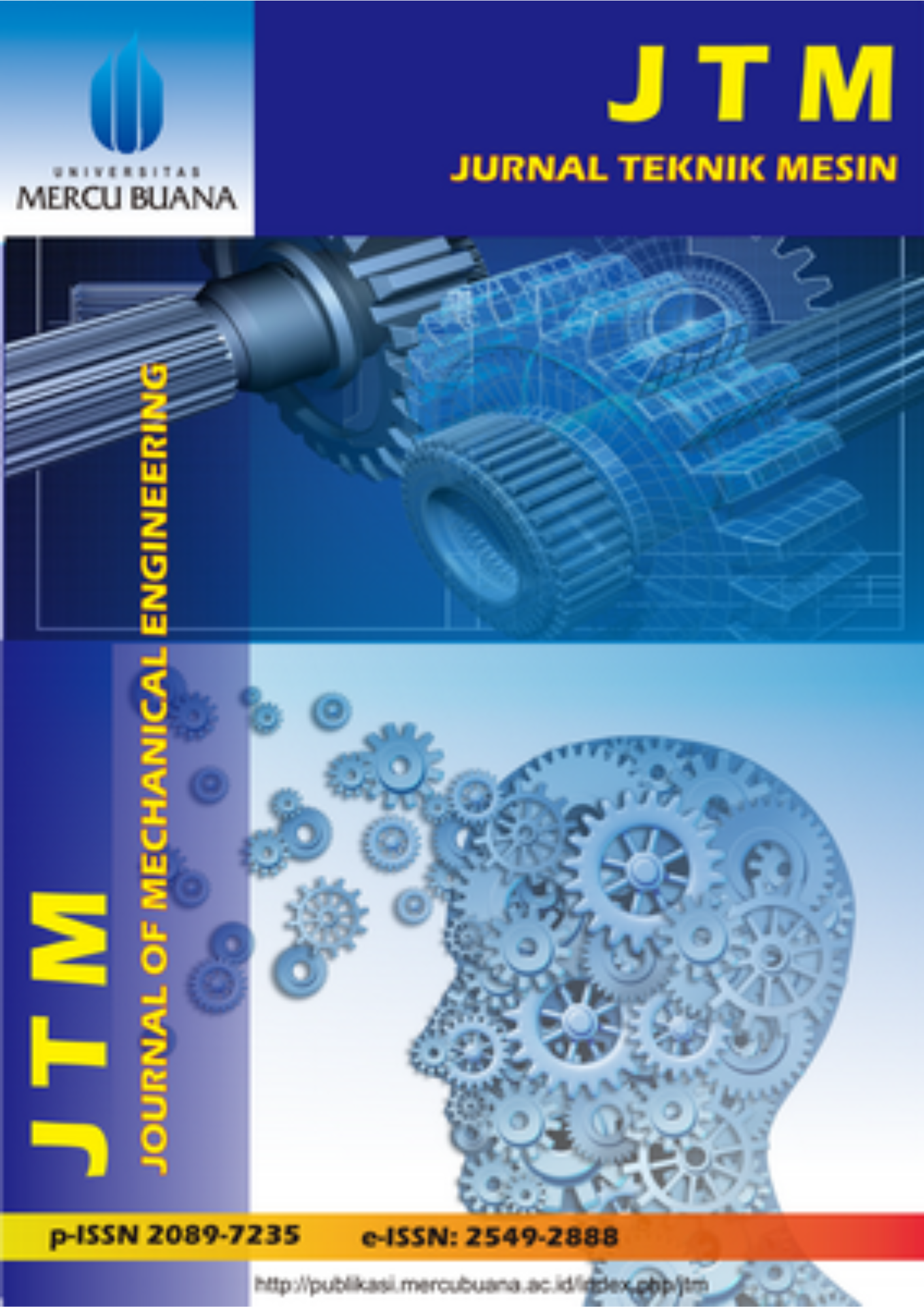DESAIN CETAKAN SPESIMEN UJI KOEFISIEN GESEK MESIN KOMPAKSI KAPASITAS 10 TON MENGGUNAKAN METODE DESIGN FOR MANUFACTURING AND ASSEMBLY
Abstract
Abstrak-- Mesin kompaksi merupakan sebuah alat yang berfungsi untuk memadatkan material komposit serbuk serat alam matriks polimer. Umumnya, pada pembuatan material komposit secara manual hanya menggunakan kandungan serat tidak lebih dari 10% sehingga sifat mekanis yang didapat tidak meningkat. Oleh karena itu, material komposit perlu dikompaksi menggunakan mesin kompaksi agar kandungan seratnya dapat ditingkatkan dibandingkan dengan kandungan polimernya supaya sifat mekanisnya dapat meningkat. Salah satu komponen penting dari mesin kompaksi yaitu dies dan punch yang berperan penting dalam pembentukan material. Oleh karena itu, komponen dies dan punch perlu dibuat sesuai dengan kebutuhan. Dalam pembuatan dies dan punch, proses perakitan dan manufaktur mempunyai peranan penting. Penelitian ini bertujuan untuk merancang komponen dies dan punch dengan 3 variasi desain yaitu desain 1, 2, dan 3 untuk ditemukan desain yang terbaik serta efisien. Pembuatan dies dan punch dilakukan dengan menggunakan konsep Design for Manufacturing and Assembly (DFMA). Konsep DFMA ditujukan untuk mendapatkan jumlah komponen, dan waktu perakitan yang paling efisien. Penelitian ini mendapatkan hasil desain yang terbaik yaitu desain 3 dengan jumlah komponen 4 part, efisiensi sebesar 19,63%, serta estimasi biaya manufaktur sebesar Rp1.278.500,00. Sedangkan desain 1 dan 2 memiliki jumlah komponen 7 part dan 5 part, efisiensi desain sebesar 26,78% dan 13,54%, dan estimasi biaya manufaktur sebesar Rp2.361.630,00 dan Rp2.160.000,00. Hasil desain 3 ini dapat mereduksi jumlah komponen sebesar 3 part, meningkatkan efisiensi desain sebesar 6,09%, serta mereduksi biaya manufaktur sebesar Rp1.083.130,00.
Kata kunci: Komposit, Desain, Dies dan Punch, DFMA, Rancangan yang Efisien
Abstract-- Compaction machine is a tool that serves to compact the polymer matrix natural fiber powder composite material. Generally, the manufacture of composite materials manually only uses fiber content of no more than 10% so that the mechanical properties obtained do not increase. Therefore, composite materials need to be compressed using a compacting machine so that the fiber content can be increased compared to the polymer content so that the mechanical properties can be increased. One of the important components of the compacting machine is the dies and punches that play an important role in the formation of the material. Therefore, dies and punch components need to be made as needed. In making dies and punches, the assembly and manufacturing process has an important role. This research aims to design dies and punch components with 3 design variations, namely design 1, 2, and 3 to find the best and efficient design. Making dies and punches is done using the concept of Design for Manufacturing and Assembly (DFMA). The DFMA concept is aimed at getting the most efficient number of components, and assembly time. This study obtained the best design results, namely design 3 with the number of components of 4 parts, efficiency of 19.63%, and estimated manufacturing costs of IDR 1,278,500.00. While designs 1 and 2 have the number of components of 7 parts and 5 parts, design efficiency of 26.78% and 13.54%, and estimated manufacturing costs of IDR 2,361,630.00 and IDR 1,278,500.00, respectively.
Keywords: Composite, Design, Dies and Punch, DFMA, Efficient Design
Keywords
Full Text:
PDF (Bahasa Indonesia)DOI: http://dx.doi.org/10.22441/jtm.v13i1.24581
Refbacks
- There are currently no refbacks.
Copyright (c) 2024 Jurnal Teknik Mesin
Jurnal Teknik Mesin (JTM)
Program Studi Teknik Mesin, Fakultas Teknik, Universitas Mercu Buana
Jl. Meruya Selatan No. 01, Kembangan, Jakarta Barat 11650, Indonesia
Email: [email protected]
Telp.: 021-5840815/ 021-5840816 (Hunting)
Fax.: 021-5871335
JTM is indexed by the following abstracting and indexing services:

This work is licensed under a Creative Commons Attribution-NonCommercial 4.0 International License.






.png)







_(486_x_90_px)_(486_x_190_px)_(486_x_190_px)_(4).png)
_(486_x_90_px)_(486_x_190_px)_(486_x_190_px)_(5).png)
2.png)
.png)